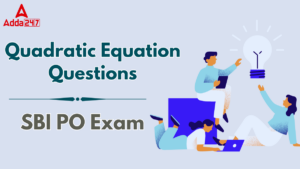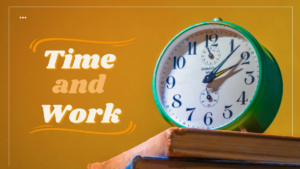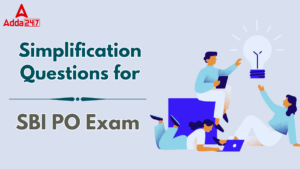Dear Students,
Quantitative Aptitude Section has given heebie-jeebies to the aspirants when they appear for a banking examination. As the level of every other section is only getting complex and convoluted, there is no doubt that this section, too, makes your blood run cold. The questions asked in this section are calculative and very time-consuming. But once dealt with proper strategy, speed, and accuracy, this section can get you the maximum marks in the examination. Following is the Quantitative Aptitude quiz to help you practice with the best of latest pattern questions.
Following the study plan for SBI PO Preliminary Examination 2018, the seventh week starts with practice questions on Miscellaneous Questions Set. To ensure proper preparation of the section we advise you to go through all the questions sincerely and try to attempt each one of them. Afterward, match your solutions and the approach with the one that would be provided later. Practice more and more questions on the same section to enhance your grip over the topics. Following is the Quantitative Aptitude quiz to help you practice with the best of latest pattern questions.
Q1. The vehicle of Mr. Ghosh needs 30% more fuel at the speed of 75 kmph than it needs at the speed of 50 kmph. At a speed of 50 kmph, Mr. Ghosh can go to a distance of 195 km. At the speed of 75 kmph, what distance he will travel?
(a)125 km
(b)150 km
(c)140 km
(d)175 km
(e)200 km
Q2. A shopkeeper sells goods on 20% profit. When he purchases on 10% more and sells it on 25% profit then he gets Rs. 14 more. What is the initial cost price of goods?
(a)Rs. 80
(b)Rs. 100
(c)Rs. 125
(d)Rs. 105
(e)Rs. 400
Q3. By selling an article for Rs. 160, a dealer makes 20% loss. Next time, the dealer sold the same article in such a way that he gained 25%. What is the difference between the percentage increase in his selling price and percentage loss made by him earlier?
(a)26.75%
(b)30%
(c)36.25%
(d)34.25%
(e)None of these
Q4. A playground is in the shape of a rectangle. A sum of Rs. 1000 was spent to make
the ground usable at the rate of 25 paise per sq. m. The breadth of the ground is 50m. If
the length of the ground is increased by 20 m, what will be the expenditure in making this ground usable at the same rate?
(a) Rs.1500
(b) Rs.2250
(c) Rs.1250
(d) Rs.1000
(e) Rs. 1800
Q5. The probabilities of solving a problem by three students. A, B and C are 1/2,1/3 and 1/4, respectively. The probability that the problem will be solved, is
(a)1/4
(b)1/2
(c)3/4
(d)1/3
(e) 3/5
Q6. A mixture of a certain quantity of milk with 16 litres of water is worth Rs 3 per litre. If pure milk be worth Rs 7 per litre how much milk is there in the mixture? (assume water is freely available)
(a) 10 litres
(b) 12 litres
(c) 14 litres
(d) 16 litres
(e) 20 liters
Q7. A and B alone can complete a piece of work in 80 days and 120 days respectively. They started working together but A left after 20 days. After another 12 days C joined B and they completed the work in 28 more days. In how many days can C alone complete the work?
(a) 110 days
(b) 112 days
(c) 114 days
(d) 120 days
(e) 124 days
Q8. In an examination, the ratio of passed students to failed students were in the ratio 25 : 4. If five more students had appeared and the number of failed students was 2 less than earlier, the ratio of passed students to failed students would have been 22 : 3. Find the no. of students appeared initially.
(a) 145
(b) 150
(c) 155
(d) 180
(e) 200
Q9. A man can row at the rate of 4 km/hr in still water. If the time taken to row a certain distance upstream is 3 times as much as to row the same distance downstream, find the speed of the current?
(a) 3 km/hr
(b) 1.5 km/hr
(c) 1 km/hr
(d) 2 km/hr
(e) 0.5 k/hr
Q10. Two trains A and B are running on parallel tracks in the same direction. Train A which is coming from behind takes 50 seconds to cross B completely. One person in train A observes that he crosses train B in 30 seconds. If the speed of the train A and train B is in the ratio of 2: 1, what is the ratio of their lengths?
(a) 1 : 2
(b) 2 : 3
(c) 4 : 3
(d) 5 : 3
(e) 5 : 4
Directions (Q11-Q15): Find out the approximate value which should come in place of the question mark (?) in the following questions.
Note: (You are not expected to find out the exact value)
Q11. 89.988% of 699.9 + 50.002% of 999.99 – 170.015 =?
(a) 990
(b) 900
(c) 920
(d) 960
(e) 860
(a)125 km
(b)150 km
(c)140 km
(d)175 km
(e)200 km
Q2. A shopkeeper sells goods on 20% profit. When he purchases on 10% more and sells it on 25% profit then he gets Rs. 14 more. What is the initial cost price of goods?
(a)Rs. 80
(b)Rs. 100
(c)Rs. 125
(d)Rs. 105
(e)Rs. 400
Q3. By selling an article for Rs. 160, a dealer makes 20% loss. Next time, the dealer sold the same article in such a way that he gained 25%. What is the difference between the percentage increase in his selling price and percentage loss made by him earlier?
(a)26.75%
(b)30%
(c)36.25%
(d)34.25%
(e)None of these
Q4. A playground is in the shape of a rectangle. A sum of Rs. 1000 was spent to make
the ground usable at the rate of 25 paise per sq. m. The breadth of the ground is 50m. If
the length of the ground is increased by 20 m, what will be the expenditure in making this ground usable at the same rate?
(a) Rs.1500
(b) Rs.2250
(c) Rs.1250
(d) Rs.1000
(e) Rs. 1800
Q5. The probabilities of solving a problem by three students. A, B and C are 1/2,1/3 and 1/4, respectively. The probability that the problem will be solved, is
(a)1/4
(b)1/2
(c)3/4
(d)1/3
(e) 3/5
Q6. A mixture of a certain quantity of milk with 16 litres of water is worth Rs 3 per litre. If pure milk be worth Rs 7 per litre how much milk is there in the mixture? (assume water is freely available)
(a) 10 litres
(b) 12 litres
(c) 14 litres
(d) 16 litres
(e) 20 liters
Q7. A and B alone can complete a piece of work in 80 days and 120 days respectively. They started working together but A left after 20 days. After another 12 days C joined B and they completed the work in 28 more days. In how many days can C alone complete the work?
(a) 110 days
(b) 112 days
(c) 114 days
(d) 120 days
(e) 124 days
Q8. In an examination, the ratio of passed students to failed students were in the ratio 25 : 4. If five more students had appeared and the number of failed students was 2 less than earlier, the ratio of passed students to failed students would have been 22 : 3. Find the no. of students appeared initially.
(a) 145
(b) 150
(c) 155
(d) 180
(e) 200
Q9. A man can row at the rate of 4 km/hr in still water. If the time taken to row a certain distance upstream is 3 times as much as to row the same distance downstream, find the speed of the current?
(a) 3 km/hr
(b) 1.5 km/hr
(c) 1 km/hr
(d) 2 km/hr
(e) 0.5 k/hr
Q10. Two trains A and B are running on parallel tracks in the same direction. Train A which is coming from behind takes 50 seconds to cross B completely. One person in train A observes that he crosses train B in 30 seconds. If the speed of the train A and train B is in the ratio of 2: 1, what is the ratio of their lengths?
(a) 1 : 2
(b) 2 : 3
(c) 4 : 3
(d) 5 : 3
(e) 5 : 4
Directions (Q11-Q15): Find out the approximate value which should come in place of the question mark (?) in the following questions.
Note: (You are not expected to find out the exact value)
Q11. 89.988% of 699.9 + 50.002% of 999.99 – 170.015 =?
(a) 990
(b) 900
(c) 920
(d) 960
(e) 860
Q13. 6999 ÷ 70.005 × 94.998 = ? × 19.999
(a) 475
(b) 420
(c) 320
(d) 540
(e) 525
Q14. 127.001 × 7.998 + 6.05 × 4.001 = ?
(a) 1440
(b) 1400
(c) 1000
(d) 1040
(e) 1140
Q15. 50.001% of 99.99 ÷ 49.999 = ?
(a) 1
(b) 0.1
(c) 0.01
(d) 0.02
(e) 0.08
You may also like to Read:
- Quantitative Questions for upcoming Banking and Insurance Examinations
- Study Notes of Quantitative Aptitude
- Practice More Data Interpretation Questions
- Quantitative Aptitude Section Strategy
Download SBI Clerk Admit Card Here
https://www.adda247.com/sbi-clerk-admit-card.html






 Quadratic Equation Questions for SBI PO ...
Quadratic Equation Questions for SBI PO ...
 Time and Work Formula, Concept & Apt...
Time and Work Formula, Concept & Apt...
 Simplification Questions for SBI PO Exam
Simplification Questions for SBI PO Exam




